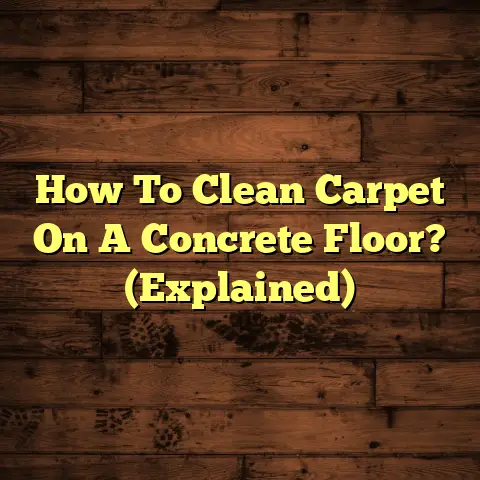Flooring Cost Comparison Chart (Explained)
Flooring Cost Comparison Chart (Explained)
When considering a flooring upgrade, particularly with hardwood, understanding the costs involved is crucial for any homeowner or property manager. This article delves into the various factors impacting the cost of hardwood flooring installation, provides detailed price ranges for different project sizes and types, compares hardwood with alternative flooring options, and offers insights on maintenance and care.
Major Cost Factors Impacting Hardwood Flooring Installation
1. Area Size
The size of the area to be floored has a direct correlation with costs. Larger areas typically result in a lower cost per square foot due to economies of scale. Conversely, smaller areas may see higher prices per square foot as the fixed costs of installation remain constant.
2. Hardwood Type
Different types of hardwood come with varying price points. Common options include:
- Oak: A popular choice known for its durability and affordability, generally ranging from $3 to $8 per square foot.
- Maple: Slightly more expensive, typically between $4 to $9 per square foot, offering a smooth grain and light color.
- Cherry: Known for its rich color and fine grain, costs can range from $5 to $12 per square foot.
- Walnut: A premium option, walnut flooring may range from $7 to $15 per square foot.
3. Labor Costs
Labor costs can vary significantly based on location, complexity of the installation, and the expertise of the contractors. On average, labor costs can range from $2 to $5 per square foot.
4. Additional Considerations
- Floor Removal: If existing flooring needs to be removed, costs typically range from $1 to $3 per square foot.
- Subfloor Replacement: If the subfloor is damaged, replacing it can add another $2 to $5 per square foot.
- Material Grade: Higher grades of wood or specialty woods will increase overall costs.
- Room Size/Layout: Complex layouts may require more cutting and fitting, driving up labor costs.
- Installation Type: Solid wood installation tends to be more expensive than engineered wood due to the complexity of the process.
Detailed Cost Breakdown
Small Project (100 sq. ft.)
- Material:
- Oak: $300 – $800
- Maple: $400 – $900
- Labor: $200 – $500
- Total Estimated Cost: $500 – $1,300
Medium Project (500 sq. ft.)
- Material:
- Oak: $1,500 – $4,000
- Maple: $2,000 – $4,500
- Labor: $1,000 – $2,500
- Total Estimated Cost: $2,500 – $6,500
Large Project (1,000 sq. ft.)
- Material:
- Oak: $3,000 – $8,000
- Maple: $4,000 – $9,000
- Labor: $2,000 – $5,000
- Total Estimated Cost: $5,000 – $13,000
Hardwood vs Alternative Flooring Options
| Flooring Type | Average Cost (per sq. ft.) | Pros | Cons |
|---|---|---|---|
| Hardwood | $3 – $15 | Durable, aesthetic appeal | Can be expensive |
| Laminate | $1 – $5 | Affordable, easy maintenance | Less durable than hardwood |
| Vinyl | $1 – $4 | Water-resistant, affordable | Can look less authentic |
| Carpet | $2 – $6 | Comfortable, sound-dampening | Stains easily, less durable |
Signs That Hardwood Floors Need Replacement
- Deep Scratches or Gouges: If repairs are too extensive or frequent.
- Warping or Buckling: Often due to moisture issues; replacement may be necessary.
- Severe Discoloration: Indicates damage beyond refinishing.
- Persistent Odours: Could signal underlying issues like mould.
Refinishing vs Replacement
- Refinishing is a cost-effective solution for minor scratches and wear but may not be suitable for severely damaged floors.
- Replacement is ideal when the floor is beyond repair or if you wish to upgrade to a different wood type.
Pros and Cons of Hardwood Flooring
Pros
- Aesthetic Appeal: Enhances the beauty of any space.
- Durability: Can last for decades with proper care.
- Increased Property Value: Often boosts resale value.
Cons
- Costly Installation: Higher upfront costs compared to other flooring types.
- Maintenance Requirements: Requires regular upkeep to maintain appearance.
- Susceptibility to Moisture: Not ideal for high-moisture areas unless treated properly.
Professional Installation vs DIY
Cost Differences
- Professional Installation: Typically ranges from $2 to $5 per square foot for labor.
- DIY Installation: While you save on labor costs, you’ll need tools that could range from $200 to over $1,000 depending on what’s required.
Skills Required
DIY installation requires knowledge of flooring techniques and tools. Inexperienced installers may face issues that lead to costly repairs in the future. Professional installers bring expertise in ensuring a flawless finish.
Questions to Ask Hardwood Flooring Contractors
- What types of wood do you recommend for my project?
- Can you provide references from previous clients?
- What is included in your estimate?
- How long will the installation take?
- What are your warranty policies?
Hardwood Floor Care and Maintenance Tips
- Regular Cleaning: Sweep or vacuum regularly to remove dirt and dust.
- Use Appropriate Cleaners: Avoid harsh chemicals; use cleaners specifically designed for hardwood.
- Control Humidity Levels: Maintain indoor humidity between 30% and 50% to prevent warping.
- Place Mats at Entrances: This helps reduce dirt and moisture tracked onto floors.
In conclusion, investing in hardwood flooring can be a significant decision that enhances your space’s aesthetics and value. Understanding the cost factors and making informed choices will lead to a successful flooring project that meets your needs and expectations. Whether you’re leaning towards professional installation or considering a DIY approach, being well-informed sets the foundation for a lasting investment in your home or business.





